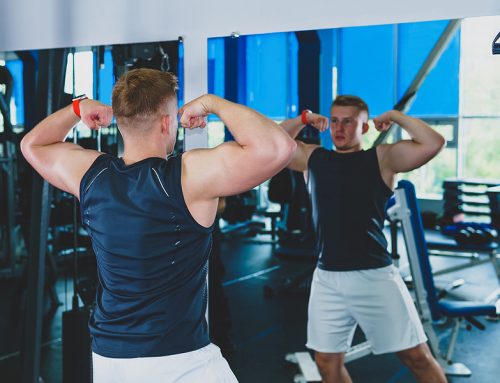Many lifters are worried about muscle loss (atrophy), even when they’re still lifting. When they think of taking breaks from the gym completely, whether it’s by choice or it’s a forced layoff due to injury or illness, their fear of shrinking muscles turns to terror! What will taking a week or two off of lifting really do to your muscle gains? In today’s post, we answer a reader question about this topic – layoffs and muscle loss – plus, a look at the influence of training frequency on muscle gains (or losses).
Q: Tom, I’ve been wondering about muscle loss, or when a muscle atrophies, and I have a few different questions on this subject: 1. If I’m training one part of the body, like only upper body, or even only arms, but I never train the legs, does this mean that lean body mass in my legs will be lost? 2. If I train one muscle group today, how long will that training stimulus stay active for? Will that muscle be preserved for let’s say, a week? If I don’t work the same group the week after, will it still be preserved or by then, will it start to be catabolized? 3. If I need to take a complete layoff from training, how long will it take before I start to lose muscle overall?
A: These are great questions! All the important issues regarding muscle atrophy and detraining are right there in those three questions. Your second question also ties right into the popular conversations on the optimal training frequency that have been going on in the bodybuilding and strength training community recently. Let me cover all these issues in order one by one.

Will untrained muscles atrophy?
If you were training for a while and built up your muscle mass to a higher level than it was when you were sedentary, and then you stopped training completely, you would expect that muscle to atrophy – that’s common sense and an almost obvious conclusion.
How much would your muscles shrink? Well, your muscles would not atrophy to the point of looking like a prisoner of war or starvation victim, as long as you weren’t starving and you weren’t immobilized (taking total bed rest, or having a limb in a cast for an extended period will cause massive atrophy). You would however, lose most or all of the “extra” muscle you had gained from training, and ultimately end up back at the body appearance and lean body mass level where you started.
That is to say, you’d reverse back to looking like a normal untrained person, but you wouldn’t waste away as if you were sick. Genetics will influence this to some degree, but keeping calories at maintenance levels and simply engaging in the normal activities of daily life will maintain a normal-looking body in terms of muscularity.
Muscle gained is not muscle you’re going to keep without continued effort. Use it or lose it is the law.
The good news is, it’s easier to keep muscle you have than to gain new muscle. Even a simple low volume, low frequency lifting routine done two or three days a week can help you keep what you have, and this is good to know during busy times of your life.
If you choose to train only one muscle or one section of your body and not train the rest, you can expect the above to more or less hold true as well. The untrained muscles will have an untrained appearance, while the trained muscles will stay well-developed.
There may be an overlap effect, because during compound exercises, a primary mover is doing the brunt of the work, but secondary muscles are assisting. When you do a push up, you might think of that as only training your chest, but actually your triceps are getting worked hard, so are your front deltoids and even your core and hips are being activated.
Even though it’s an indirect stimulus, that can be enough to maintain muscle in many body parts. You would have to do a pulling exercise however, or the upper back and biceps would be getting neglected and would decrease in size and strength relative to the pushing muscles.
Some people theorize that there’s some kind of cross-transference or carryover between the upper and lower body. For example, some people say if you squat, your whole body grows. In reality, there’s very little benefit to the upper body from lower body training or vice versa. If anything, some muscles in the upper body are simply getting indirect work as a result of supporting and holding the barbell on your shoulders, or maybe holding the weights when you do a dumbbell lunge and so on.
Speaking of legs, they’re also different than the upper body because you’re always walking around on them, climbing up stairs, occasionally squatting down to pick something up and so on, so they get a low-level stimulus all the time and that maintains a certain amount of muscle tone. The upper body is more likely to atrophy without direct resistance training.
The bottom line is, just a few major exercises could cover your whole body and help you maintain muscle, but any body part you skip completely will start to slip.
There is one situation where if you don’t do resistance training, there will in fact be an overall loss of muscle that will continue to worsen over time. That is called sarcopenia, and it happens with aging. It may begin as early as 40, increases with each decade after that, and may accelerate rapidly with old age.
If you don’t resistance train as you get older, you can’t expect to maintain a “normal untrained” looking body like a young person. With every passing year after midlife, the lack of training will lead to slow but steady atrophy. At first it’s barely perceptible, but over decades, you eventually become skinny, frail, dysfunctional and no longer independent – another example of use it or lose it.
How long does the stimulus from a weight lifting workout last before the muscle starts to shrink back down?
This is the hot question in strength training research today and has led to a ton of analysis and debate about what is the optimal training frequency.
The reason for the debate is because a lot of bodybuilders work each muscle group only one time per week, which leaves six days in between before that muscle is worked again. Some people not only wonder whether that is too infrequent for optimum gains, they speculate that the muscle will start to atrophy before that next workout rolls around, making such low training frequencies ineffective and leaving gains on the table.
This assumption has been based on research about the time course of protein synthesis. Studies have shown that after lifting, protein synthesis spikes for a specific period of time, and it’s not long. It stays elevated and can peak as high as double the normal level for up to 24 hours (the day after), but then it declines rapidly and is back to baseline around 36 hours (the second day after training). Some sources say 48 hours, but either way it’s inside that ballpark of two days.
This has been interpreted as saying that if you train a muscle on Monday afternoon, protein synthesis is up the rest of the day Monday, and still elevated Tuesday, but by Wednesday, you’re probably back to baseline. Therefore, it seems logical that you’re “recovered” or at least ready enough to train that body part again on Wednesday, or certainly by Thursday. And yet, many bodybuilders have traditionally only trained each muscle once a week.
So the question comes up, are those bodybuilders missing out big time, by not training each muscle group more often? If you trained a muscle again as soon as protein synthesis had returned to baseline, would that initiate another protein synthesis spike and create another opportunity to grow muscle sooner? Differently stated, people are asking: Doesn’t it appear better to provide a muscle-building stimulus twice a week instead of only once a week?
Should You Train A Muscle Once Or Twice Per Week
In addition, this prompts another question: Does a muscle actually start to atrophy after the fourth, fifth or sixth day of not being trained? There may be validity to the protein synthesis argument, but this muscle atrophy theory doesn’t hold up under scrutiny.
It’s possible increasing your frequency of hitting each body part could improve results, but studies have shown that your muscles do not start to atrophy after even two weeks of total layoff, let alone only one week. This means that if you train with a lower than optimal frequency, you’re not going to lose muscle, it’s more accurate to say you might gain it faster if you trained more often (i.e., you make most of your genetically possible muscle gains in 2 years instead of 3 or 4 years).
The protein synthesis theory is cited as evidence supporting more frequent training, but protein synthesis is only a proxy for muscle growth, it is not actual muscle growth measured over time It also doesn’t factor in the rate of protein breakdown. So in my opinion, that theory alone does not give us the final say about how often you should train each muscle for optimal growth.
The fact is, thousands of bodybuilders have succeeded working each muscle only once a week. Most experts today don’t consider that optimal, but you can’t deny that it works, including among bodybuilding pros and elites. There are also countless more bodybuilders following training frequencies somewhere in between once and twice a week, such as hitting each muscle once every 4, 5 or 6 days (usually I work each muscle once every 4 or 5 days).
While “Work each muscle twice a week for optimal muscle growth” is considered the best practice that applies to and works for the largest percentage of people, it is not a rule set in stone and It certainly does not apply in reverse and tell us that we will lose the muscle we already gained if we don’t train with high frequency. The theory that your muscles start to atrophy if you don’t train them at least twice a week is simply not true.
Layoffs and rest breaks: How much time can you take off before you start to atrophy?
How long does it take after you stop training everything before you start to atrophy? A combination of research and experience suggests that layoffs of one week and even up to two weeks are not detrimental.
Carefully planned layoffs that let you rest when you need it may be more advantageous than training continuously. This appears logical on the surface purely from a recovery standpoint, but it may go even deeper because time off may allow your muscles to “re-sensitize” to the training stimulus.
One way you know your body adapts after you keep training for an extended period is because your rate of progress – strength and muscle gain – begins to drop off. But when you come back from a layoff, you often notice that you get a spurt of rapid gains once again and you feel mentally refreshed after getting a break from the psychological pressure of constantly pushing yourself. Therefore, the rest break helps facilitate greater gains in the long term.
In a study published in the European Journal of Applied Physiology, subjects in one group took 3 weeks off after 6 weeks of training, then another 3 weeks off, followed by 6 more weeks of training. The subjects in a second group trained straight through for the entire 24 weeks. You might think the continuous training group would have fared a lot better because they did 6 more weeks of training in total, but there was very little difference.
In this case, there was some muscle size lost toward the end of the 3 week long breaks, but they regained it so quickly, over the long haul, they ended up with near the same results as the continuous group. This study was done on beginners so we don’t know if the same thing will happen in experienced trainees (an important question), but it does raise a discussion about whether the strategic use of time off (“detraining” periods) could re-sensitize muscle tissue to training again after your muscles have started to experience the adaptation and plateau effect.
Another study from Baylor University had subjects train for 4 weeks on, 2 weeks off, and another 4 weeks on and 2 weeks off. They were interested in testing the detraining effect of 2 week layoffs as well as the effect of protein supplements during the process. Neither group – the protein supplemented or the non supplemented group – lost lean body mass from taking two week layoffs.
A huge number of people are scared to take time off because they fear losing their gains, but if breaks are taken, not randomly because motivation has left the building or you got busy, but as part of a carefully structured plan, you are probably better off for it than if you didn’t take time off. Even if the re-sensitization theory doesn’t completely explain the benefits, taking training breaks makes perfect sense, and is almost an obvious necessity at times to allow for optimal recovery, physically and mentally.
The question still remains, how often to take off, and how long. This is still being researched and debated, but we at least have some good guidelines already. To avoid the atrophy issue, most experts agree that it’s not detrimental to take one or even two weeks off at a time.
Evidence and experience also suggest that these layoffs are ideally taken after an extended block of hard training. Saying that you can take a week or two off without detriment doesn’t mean you should take a week off after every week of training. You probably wouldn’t even need to take a week off after every month, though that idea has been floated by some trainers.
It’s also pretty clear that the length of the training block should be quite a bit longer than the rest break. A common recommendation is to take one week off after every 12 weeks of training or after every macrocycle (a major phase of training). Ironically, a lot of type-A lifters won’t even do it that often because they think four weeks off every year is too much rest.
Part of the decision should probably be left up to the lifter based on how they feel they are growing and recovering (or not), as well as based on their mental state and enthusiasm level. If you’re burned out, a break is in order. If joints and tendons are starting to ache, a break is in order.
If you take your breaks using the guidelines above, you have nothing to worry about with regards to muscle loss. If you are forced to take a layoff for injury, illness or heavy work schedules, it’s good to know that even two or three unplanned weeks off is not the end of the world, and could be good for you if you were pounding it in the gym for many months prior.
If you ever do lose muscle, and even if you have an extended layoff, you can take solace in the fact that muscle memory exists and your muscles may re-sensitize, and you are primed mentally and physically upon your return to make a quick spurt of big gains. It’s like you get to enjoy the “newbie gains” all over again. A closer look at muscle memory and the science behind it will be the topic of a future post.
Summary:
1. If you let a lot of time elapse between workouts for a particular muscle group, such as the “train each body part once a week split,” you will not atrophy or lose muscle, but it’s possible you might not be optimizing gains either. Many experts believe the ideal lifting frequency is working each muscle about two times per week, or close to it, though bodybuilders do often get impressive gains on split routines that work each muscle only once every 5 to 7 days, if the volume is high enough.
2. You won’t lose any muscle at all from taking a week off, and taking breaks when your body needs them will help your muscle growth long term because time off lets your body recover and you may avoid overuse injuries that could interfere with your training.
3. You probably won’t even lose muscle from two weeks off, though one week layoffs are more common among enthusiastic physique athletes. If you do take two weeks off, any detraining effects will be minimal and will not set you back over the long run as long as you’re not taking those layoffs too often.
4. If you take off three weeks, you may start seeing muscle atrophy or detraining effects, but it won’t be severe, and when you return to training, you will gain it back rapidly due to muscle memory and or the muscle re-sensitizing effect of rest.
-Tom Venuto, Author of, Burn the Fat, Feed the Muscle (BFFM)
Author of, The BFFM Guide To Flexible Meal Planning For Fat Loss
Founder of, Burn the Fat Inner Circle
PS. Want to increase your gains? Check out The Burn The Fat, Feed The Muscle Guide To Building Muscle With Progressive Overload Training, available for instant download.

Tom Venuto is a natural bodybuilding and fat loss expert. He is also a recipe creator specializing in fat-burning, muscle-building cooking. Tom is a former competitive bodybuilder and today works as a full-time fitness coach, writer, blogger, and author. In his spare time, he is an avid outdoor enthusiast and backpacker. His book, Burn The Fat, Feed The Muscle is an international bestseller, first as an ebook and now as a hardcover and audiobook. The Body Fat Solution, Tom’s book about emotional eating and long-term weight maintenance, was an Oprah Magazine and Men’s Fitness Magazine pick. Tom is also the founder of Burn The Fat Inner Circle – a fitness support community with over 55,000 members worldwide since 2006. Click here for membership details
Scientific References
Bickel CS, et al, Exercise dosing to retain resistance training adaptations in young and older adults, Medicine and Science In Sports And Exercise, 43, 1177-1187, 2011
Hakkinen K et al, Neuromuscular adaptation during prolonged strength training, detraining and re-strength training in middle aged and elderly people, Eur J App Phys, 83(1), 51-62, 2000.
Gavanda, S et al, Three Weeks of Detraining Does Not Decrease Muscle Thickness, Strength or Sport Performance in Adolescent Athletes, Int J Exerc Sci. 13(6): 633–644. 2020.
Hwang, The Effects of Short-Term Detraining and Subsequent Retraining on Body Composition and Muscle Performance in Males Consuming a Whey Protein or Carbohydrate Supplement, Intl J Exer Sci, vol 2: 8, 2016.
McDougall JD, et al, The time course for elevated muscle protein synthesis following heavy resistance exercise. Can J Appl Physiolo. 20(4): 480-486, 1995.
Ogasaware R,et al, Comparison of muscle hypertrophy following 6-months of continuous and periodic strength training. Eur J Appl Physiolo, 113(4): 975-985, 2012.






Leave A Comment